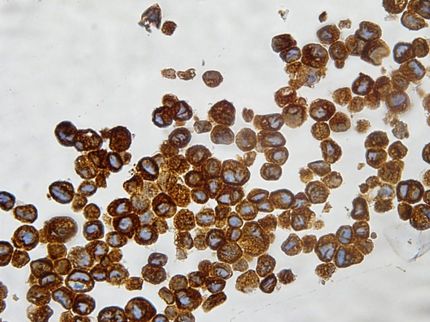Study of biomarker development in mice provides a roadmap for a similar approach in humans
Researchers at Fred Hutchinson Cancer Research Center have demonstrated in mice that the performance of a novel biomarker-development pipeline using targeted mass spectrometry is robust enough to support the use of an analogous approach in humans. The findings, by principal investigator Amanda Paulovich, M.D., Ph.D., an associate member of the Hutchinson Center's Clinical Research Division, are published in Nature Biotechnology.
Paulovich and colleagues demonstrated that a staged, targeted pipeline approach using mass spectrometry to prioritize and validate proteins of interest enabled them to test a far larger number of biomarker candidates than would have been possible using conventional technologies, making a substantial improvement over the current state of biomarker evaluation.
"If, as we hope, this approach enables more efficient translation of novel biomarkers into use as diagnostic tests, the effect will be an improved ability to personalize medicine by optimizing our treatment of individual patients, thus improving patient outcomes and also helping to contain health care costs," Paulovich said.
The researchers undertook this proof-of-concept study in an attempt to accelerate and streamline the process of biomarker candidate testing because, over nearly a decade, hundreds of millions of dollars have been spent on the discovery of promising protein biomarkers of human diseases, particularly biomarkers found in the blood. Despite this significant investment, the number of new FDA-approved blood-based biomarkers has remained very low.
Several factors have contributed to this low return on investment. Each promising biomarker must be further studied in clinical trials, which requires researchers to measure the abundance of each candidate biomarker in hundreds of patient samples. Because the odds are extraordinarily low that any one biomarker candidate will provide clinically useful information, large numbers of candidates must be tested if there is to be any hope of identifying a clinically useful biomarker.
"Unfortunately, there is a major bottleneck in the biomarker-development pipeline because there are no quantitative tests for the majority of human proteins," Paulovich said. "As a result, tests must be developed from scratch for clinical analysis of candidate biomarkers, and this process is prohibitively expensive for testing large numbers of candidate proteins. As a result, few promising biomarkers undergo rigorous validation, and the literature is replete with lists of candidates that have not been thoroughly tested."
For the project, Paulovich and colleagues used a highly sensitive and targeted analytical technology – selected reaction monitoring mass spectrometry. This type of mass spectrometry is not new – it has been used for years in clinical laboratories worldwide to measure drug metabolites and small molecules associated with inborn errors of metabolism. What is new is their pioneering use of this technology in a pipeline to test candidate protein biomarkers. Unlike traditional mass spectrometry, which attempts to detect all proteins in a biological sample in a scattershot fashion, this technology is highly targeted, allowing researchers to calibrate the equipment to specifically look for peptides, or protein fragments, of interest, filtering out the rest as white noise.
Targeted mass spectrometry methods, particularly when combined with antibody-based enrichment of target proteins, provide a technology platform for highly specific, reproducible and sensitive quantification of many proteins from a small drop of blood. Mass spectrometry-based tests have several advantages over traditional technologies, and they can be performed more quickly and at a lower cost.
"We aimed to test the possibility that a staged biomarker pipeline based on targeted mass spectrometry would enable the prioritization and testing of very large numbers of candidate biomarkers in preclinical trials. The hope was that this would enable more comprehensive testing of candidate biomarkers and thus a greater success rate for clinical validation."
Stage one of the biomarker discovery pipeline involved using targeted mass spectrometry to detect candidate biomarker proteins in the blood. Stage two sought to determine whether these proteins were elevated in the blood of mice with breast cancer as compared to healthy mice. Stage three involved developing blood tests that could be used in preclinical trials to detect the most promising protein candidates associated with early breast cancer development.
Although previous work, including that of Paulovich and colleagues, had analyzed the performance of the individual stages in isolation, these components had never before been assembled into a pipeline, and the numbers of proteins tested in previous studies were generally too small to demonstrate the feasibility of translating to clinical use.
For the study, the researchers tested 80 blood samples from healthy control mice and mice harboring preclinical or clinically apparent breast cancers. They also studied a group of mice that experience conditions that commonly affect the results of cancer screening tests. The researchers found 36 blood biomarkers of breast cancer in this mouse model. Of these, two were elevated in the blood of tumor-bearing mice before the tumors could be seen or felt, indicating that they enabled early detection of the cancers.
The purpose of the study was not to find biomarkers for breast cancer that would be of use in humans, but rather to develop and test technologies in a preclinical model before embarking on human studies. "It remains to be tested whether any of the specific biomarkers identified in the mouse will be of use in humans, where disease and biological variation will be much greater than in a mouse model. It is more likely that we have developed a road map for conducting more effective biomarker studies in humans," Paulovich said.
Other news from the department science
Most read news
More news from our other portals
See the theme worlds for related content
Topic World Mass Spectrometry
Mass spectrometry enables us to detect and identify molecules and reveal their structure. Whether in chemistry, biochemistry or forensics - mass spectrometry opens up unexpected insights into the composition of our world. Immerse yourself in the fascinating world of mass spectrometry!

Topic World Mass Spectrometry
Mass spectrometry enables us to detect and identify molecules and reveal their structure. Whether in chemistry, biochemistry or forensics - mass spectrometry opens up unexpected insights into the composition of our world. Immerse yourself in the fascinating world of mass spectrometry!























































